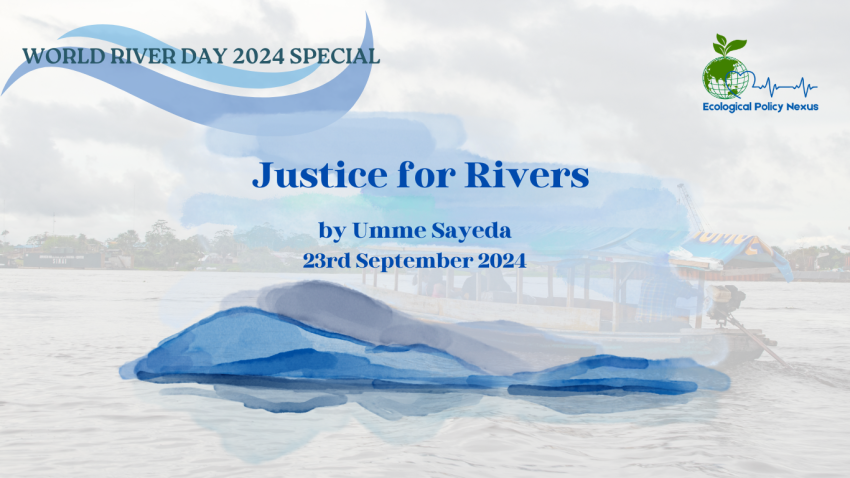Written by Umme Sayeda | 23rd September 2024| World River Day 2024 Special
On the occasion of World Rivers Day people around the world celebrate the blessings of waterways and raise awareness for the rights of rivers. This year’s World River Day theme is ‘Waterways for a Sustainable Future’. It focuses on raising awareness about the importance of water bodies as a part and parcel of biodiversity. It further highlights the significance of ensuring clean water and a secure ecosystem for the future generations.
Today’s most important questions are: Are we trying to ensure the sustainability of waterways in an effective way? What do historical human interventions in water bodies prove? Are those interventions leaving waterways and water resources for the beneficial use of our future generations? Is the scientific technological advancement to protect life and property from river delta dynamics rational? This article will attempt to shed light on these concerns. Broadly, the author will cover how the philosophical paradigm shift among mankind paved the way to industrialize rivers.
Impact of Human Philosophical Shift on Rivers
Only 5000 years ago, during the mid-Holocene era, humans began utilizing hydraulic power to establish their early civilizations, known as Old World Civilizations. Early human civilizations in Mesopotamia, the Lament, the Indus Valley, and the Central Kingdom were developed relying on the deltas of the historically important rivers, respectively, the Tigris, Jordan, Euphrates, and Nile; the Indus; and the Huang He (Yellow) and Changjiang (Yangtze) rivers. The fertile soils of the river deltas were the lifeline for irrigation, transportation, food, and even rituals. The development of human civilization was the fruit of humans’ long adaptation with dynamic rivers’ ‘making and breaking rules’.

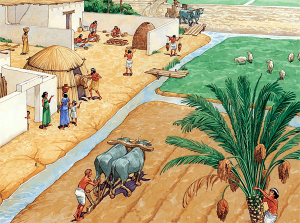
Figure1: Indus Valley Civilization; Figure2: River Civilizations
2500 years ago, ancient historian Herodotus visited Egypt and commented, “Egypt is a gift of the Nile’’. People were living complying with the rules of deltas to live in harmony with the blessings of rivers. They utilized the harmonial relationship with nature in the pre-anthropocenic era. In the Bengal delta, riverine people used to use boats as floating houses and waterways as only traffic systems connecting all Bengal before 1850.
It was not before the seventeenth and eighteenth century when the scientific revolution began, mankind questioned their religious, rituals, and cultures revolving around natural blessings with the pursuit of ‘enlightenment’. John Locke, Jean-Jacques Rousseau, Thomas Hobbes, Voltaire, and many dominating enlightenment philosophers became the mind shapers of the global philosophical landscape, particularly, in the West.
John Locke and Thomas Hobbes greatly influenced human actions and state dynamics. Their one of the most appreciated ‘concept of equality’ justified and facilitated the idea of unlimited acquisition of nature. They assumed and disseminated men are equal in labor (physical strength, reason, and prudence) so they have the equal freedom to appropriate the natural resources. In both of their terms, natural commons remained wasteful and unused so humans need to utilize their labor to use nature appropriately.
Even the idea of ‘development’ was first introduced during the enlightenment era. The popular philosophical shift was to develop the civilizations exploiting the commons using man’s ‘right to appropriate nature’. Expanded human settlements’ growing economies motivated by the freedom of natural commons exploitation and pressure of booming population aggravated the rivers’ use, in the preindustrial era.
According to the National Geographic Society, it was not before 1950 when the Anthropocene Epoch began. In this era, humans started exercising their right to exploit nature in order to transform every corner of the environment into capitals and commodities.
Problematic myths like humans are inherently selfish and born to compete for resources became widespread with the popularization of the idea of ‘the Tragedy of the Commons’. In 1968, Garrett Hardin, an ecologist and biologist wrote an essay, ‘the Tragedy of the Commons’, calling for whole privatization or nationalization of commons to restrict over-exploitation of natural resources.
Young political scientist Elinor Ostrom proved him wrong as men are not always destructive, but most of the time, they are constructive. She explored how different communities manage their shared resources with their collaborative management systems. She was one of the first scientists who studied human traditions and their importance. George Monbiot, an environmental and political activist, noted, ”The “Tragedy of the Commons” is one of the modern world’s most dangerous myths”.
During the Holocene Epoch, human civilizations maintained harmony with nature based on their traditional and cultural practices to survive. Traditional knowledge was the ‘supreme science’ before the enlightenment era. This supreme science foremostly inspired humankind to nurture nature as nature is perfectly created by God to protect and nourish them. Aftermath of the scientific revolution, human perception shifted as they began assuming them as ‘superior’ than the rest of the universe and the protector of nature.
Industrialized Rivers
Throughout the sixteenth to twentieth century, European powers dominated the world and exploited all parts of the world in the form of Imperialism and Colonialism. Industrial revolution was and will always be the means of over-exploitation during Old Imperialism and current New Imperialism.
This era introduced the shift from wood to fossil fuels and new scientific technologies that resulted in expotential ecological effect on water bodies. Industrialization of rivers started just after the 1950s.
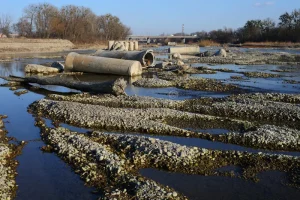
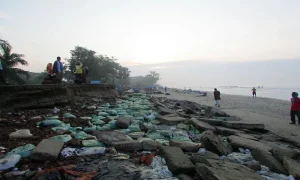
Figure3:Destruction of River-bed of the River Stock ; Figure4: The Human Story of Transformation in Coastal Bangladesh
Gertrud Haidvogl noted, “….in the nineteenth century and thereafter, shifts in technology, cultural practices, administration, and policy reflected their new roles in river management, especially in European and North American countries. Management of river risks entered a new era”. This technological transformation replaced all ‘passive flood protection’ preindustrial mechanisms with ‘active flood protection’ inductrisalized measures.
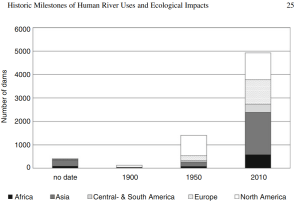
Figure: Increase of number of large dams in different geographical areas 1900, 1950, 2009
(Europe includes Russia; based on GRanD-database, Global Water System Project © 2010
In the post-colonial period, during the Cold War, the Western powers played their New imperialistic role by shaping the global financial and trade policies and implementing ‘developing the underdeveloped’ agenda. In the name of structural adjustment projects and modernization, the World Bank (WB) and International Monetary Fund (IMF) damaged the local ecosystems imposing large-scale infractures to capitalize the commons.
As part of the Global North’s modernization agenda, modern humans are now dominating the rivers by constructing permanent dams, water extraction, over extraction of fish population, hydropower projects, multi-purpose bridges-railways and so on. According to the World Worldlife Fund, world’s top ten river basins are in the following existential threats: the Salween (intrastructure-dams), La Plata (infrastructure-navigation), Danube (infrastructure-navigation and dams), Rio Grande (water over-extraction), Ganges (water over-extraction and pollution), Murray-Darling (invasive species), Indus (climate change), Nile (climate change), Yangtze (pollution), and Mekongn (over fishing).
As an illustration of such projects’ consequences, the British Raj initiated large-scale embankment projects to protect lives and property in Bengal after 1857. Following the partition of India and Pakistan, the WB and IMF funded further embankment projects in the Eastern part of Pakistan (now Bangladesh). In the past, riverine communities here used to build earthen dams and dredge canals using natural elements to lower the monsoon flood flow.
These embankment projects, while initially intended to limit flood damage, have had damaging consequences on the deltaic ecosystem and lives of the riverine people. They have disrupted the natural decomposition process to fertilize the soil for irrigation and fish production. As a result, these lead to riverbed elevation, waterlogging, and massive river erosion.
This has resulted in displacement of millions of people and loss of livelihoods. People of Bangladesh are now on the verge of losing their more than 700 deltaic connected river flow. In Bangladesh currently 308 rivers lost their navigability due to development megaprojects, pollution, illegal encroachment, and sand lifting. All of the reasons for leaving a river dead are the outcome of indiscriminate industrialization and capitalization.
From 1981 to 1993 in Bengal, riverbank erosion led to the displacement of 7,28,000 individuals. An estimated 50 million people are projected to be displaced there by 2050 as a result of environmental extremes and issues related to climate change.
Concluding Remarks
Therefore, revival of the importance of local knowledge, community based traditional practices, and stewardship worldview to nurture nature are crucial to restore our waterway sustainability for the upcoming generations. Imposed development agendas and foreign technologically advanced solutions will rather complicate the path of reaching sustainability of waterways.

